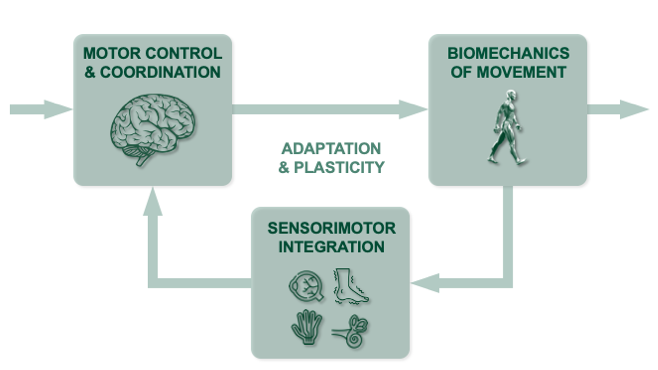What is neuromechanics?
Neuromechanics is an interdisciplinary field that combines neuroscience and biomechanics to understand how movement is controlled, coordinated, and adapted. It focuses on understanding the interaction between the nervous and musculoskeletal systems to improve mobility, stability, and overall physical performance, with a strong emphasis on applications to rehabilitation, biomedical engineering, and assistive technologies. It bridges the gap between understanding biological control systems and applying that knowledge to practical challenges in medicine and engineering.
Our Vision: A world where engineered solutions enable every individual to move freely and function fully.
Our Mission: To explore movement, design new technology, and restore ability.

Our Research Focus Areas
Motor Control and Coordination: Examining how the brain and spinal cord generate and refine signals to produce voluntary and involuntary movements. Understanding how neural circuits interact with the mechanical properties of muscles and joints to achieve smooth and efficient motion.
Biomechanics of Movement: Studying the physical forces and mechanical properties that underlie human movement, such as joint torques, muscle forces, and limb kinematics.
Sensorimotor Integration: Investigating how sensory inputs (e.g., visual, proprioceptive, and vestibular feedback) are processed by the nervous system to adapt and refine movements.
Adaptation and Plasticity: Exploring how the neuromechanical system adapts to changes such as injury, disease, or environmental conditions. Assessing how rehabilitation or training can enhance motor performance or compensate for impairments.
Our Application Areas
Rehabilitation: Developing interventions for individuals with neuromuscular impairments (e.g., stroke, spinal cord injury).
Example: Analyzing muscle activation patterns to customize gait retraining programs after a TBI.
Devices & Technology: Designing assistive technology, prosthetics/exoskeletons, virtual reality environments, clinical tools, and wearable sensors.
Example: Wearable ultrasound to monitor gait in real-time and provide feedback.
Neuromodulation & Neurostimulation: Using technology to activate neural circuits to address motor deficits.
Examples: Functional electrical stimulation, transcranial magnetic stimulation, spinal cord stimulation, peripheral nerve stimulation.
Our Lab Affiliations
We are closely affiliated with the Applied Biosensing Lab in the Bioengineering department. We share many of the same resources and personnel.
Our lab is also part of the Center for Advancing Systems Science and Bioengineering Innovation (CASSBI), a university center with a mission to advance medical technologies into the real world through human-centered design and community-engaged methodologies focused on the lived experiences of real people.
